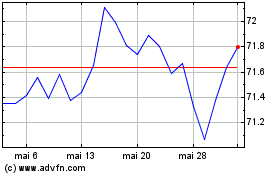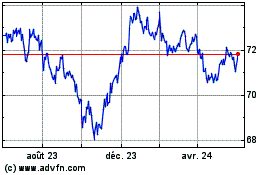The Best Bond ETF You Have Never Heard Of (FWDB) - Leveraged ETFs
28 Décembre 2011 - 10:17AM
Zacks
While equity ETFs have led the way in terms of development so
far, bond products are finally beginning to catch up to their stock
brethren. 2011 saw the debut of a host of bond ETFs including funds
that track broad emerging markets, China, and various developed
nation fixed income segments as well. While all of these were
welcomed additions to the ETF lineup, one product in particular
seemed to be an extremely intriguing way to play the broad space,
the Madrona Global Bond ETF (FWDB) from AdvisorShares.
FWDB: Global Bond ETF In Focus
FWDB launched in May of 2011 and is pretty unique among bond
ETFs that are on the market today. The product doesn’t track a
benchmark but instead looks to exceed the price and yield
performance of its benchmark, the Barclays Capital Aggregate bond
Index which is the basis for many popular funds such as AGG or BND.
The fund managers hope to achieve this by selecting a diversified
portfolio of fixed income exchange-traded products without regard
to sector or geography. In fact, the fund promises to invest in at
least 12 distinct global bond classes that cover the entire global
investable bond universe (read Go Local With Emerging Market Bond
ETFs).
This is accomplished by using two techniques based on the shape
of the yield curve and where the managers believe it will go in the
future. Yield curve analysis on a class by class basis is employed
in order to determine which section of the curve is most suitable
for investment at this current time, hopefully allocating to the
segment that has the best chance of outperformance. Furthermore,
analysts will also look at how the current curve compares to
historical averages in order to invest in products that could gain
if bonds revert to the mean. This strategy could help keep bonds
well diversified across asset classes and push investors into a
fixed income portfolio that could outperform over the long
term.
Currently, the product is heavy in investment grade corporates
which constitute one-fourth of the portfolio although
mortgage-backed securities and high yield American corporate bonds
comprise 14% and 13% of the portfolio, respectively. Beyond these
sectors, U.S. short-term government debt makes up about 7% of the
total holdings while a smattering of sectors—10 in total—make up at
least 3% of the portfolio as well (see Top Three High Yield Junk
Bond ETFs).
For this exposure, investors do have to pay a higher fee than
other bond ETFs in the space as the net operating expense ratio
comes in at 1.15% thanks to acquired fund fees and various other
expenses. While this might not sound like a lot compared to many
mutual funds, it is in fact close to ten times higher than what AGG
charges to investors. In part due to this high cost, the product
isn’t the most liquid or popular among investors as it trades about
10,000 shares a day and has AUM below $16 million, suggesting that
relatively wide bid ask spreads may be waiting for some investors
(see ETFs vs. Mutual Funds).
Since the fund’s inception, however, it has slightly
underperformed AGG from a performance perspective. Although it is
worth pointing out that the fund doesn’t exactly have a long track
record and that FWDB has outgained AGG by about 30 basis points in
the past three month period. Additionally, the yield on FWDB is far
greater than what AGG is paying out, suggesting that for those
looking for higher payouts but are still wary of taking on more
risk, the fund could be an ideal choice (read German Bond ETFs In
Focus).
This could especially be true if a bear market hits American
Treasury bonds in the near future. AGG has close to one third of
its assets in American T-Bonds and doesn’t offer up any allocations
to TIPS or international securities giving it a heavy focus on U.S.
finances. On the other hand, FWDB has a much more reasonable 16% of
its assets in the U.S. government bond sector and has assets that
are far more spread out both in terms of sector and geographic
representation (also read Can You Fight Inflation With This Real
Return ETF?).
As a result, FWDB could be the best bond ETF for investors
seeking broad allocations to the market over the long-term. Don’t
be fooled by the fund’s short-term underperformance; the techniques
involved in the construction of the fund are sound and could offer
up a better way to play the sector for most investors. So if
turmoil strikes American bonds in the near future or if foreign
securities and corporates are able to outperform in 2012, investors
will likely be glad they cycled into this more diversified, but
often overlooked bond ETF for their fixed income exposure.
Want the latest recommendations from Zacks Investment Research?
Today, you can download 7 Best Stocks for the Next 30
Days. Click to get this free report >>
To read this article on Zacks.com click here.
Zacks Investment Research
Want the latest recommendations from Zacks Investment Research?
Today, you can download 7 Best Stocks for the Next 30 Days. Click
to get this free report
Vanguard Total Bond Market (NASDAQ:BND)
Graphique Historique de l'Action
De Avr 2024 à Mai 2024

Vanguard Total Bond Market (NASDAQ:BND)
Graphique Historique de l'Action
De Mai 2023 à Mai 2024
